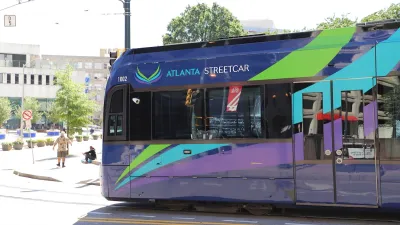Cities like Atlanta, that have grown up in the age of the automobile and air conditioning, are making efforts to green their environmentally unfriendly buildings and spaces, explains Emily Badger.
Badger points to the dual curses of the car and the air conditioner, as causing Southern cities to evolve into places with congested and sprawling interstates and centralized air enclosed buildings with small windows and no natural air flow.
"It's the difference between a city that has grown up in the automobile age and a city that has grown up before the automobile age," says Paula Vaughan, the co-director in Atlanta of the Sustainable Design Initiative at the architecture firm Perkins+Will. Older cities are inherently compact and walkable (and further on their way to sustainability) because no one was driving anywhere when they were built.
Atlanta and its younger Southern counterparts are looking to change their unsustainable ways, however. "The downtown business district has launched a Better Buildings Challenge in which property owners are pledging to reduce their energy and water consumption by 20 percent by 2020." And as of this spring, "Midtown now has a 'greenprint' – a kind of sustainability blueprint that civic leaders hope will lead the neighborhood to become the 'South's first eco-district' (following a model of existing neighborhood-scale plans in Portland and Seattle)." The proposal lays out inclusion of higher-performance buildings, more green spaces and better-connected streets with Zipcar stations and walkable sidewalks.
According to Badger, the city has already made steps to rebuild their urban form and have retrofitted numerous buildings for energy efficiency, but the Big Peach still a ways to go. "People still have that notion of sitting in the highway in your car in the 90-degree heat to get to work," Vaughan says. "We're really changing that. I think it's going to take a while before people in other cities start recognizing that. But yeah, word is getting out."
FULL STORY: How to Green Southern Cities Built in the Age of Cars and Air Conditioning

Alabama: Trump Terminates Settlements for Black Communities Harmed By Raw Sewage
Trump deemed the landmark civil rights agreement “illegal DEI and environmental justice policy.”

Study: Maui’s Plan to Convert Vacation Rentals to Long-Term Housing Could Cause Nearly $1 Billion Economic Loss
The plan would reduce visitor accommodation by 25% resulting in 1,900 jobs lost.

Why Should We Subsidize Public Transportation?
Many public transit agencies face financial stress due to rising costs, declining fare revenue, and declining subsidies. Transit advocates must provide a strong business case for increasing public transit funding.

Paris Bike Boom Leads to Steep Drop in Air Pollution
The French city’s air quality has improved dramatically in the past 20 years, coinciding with a growth in cycling.

Why Housing Costs More to Build in California Than in Texas
Hard costs like labor and materials combined with ‘soft’ costs such as permitting make building in the San Francisco Bay Area almost three times as costly as in Texas cities.

San Diego County Sees a Rise in Urban Coyotes
San Diego County experiences a rise in urban coyotes, as sightings become prevalent throughout its urban neighbourhoods and surrounding areas.
Urban Design for Planners 1: Software Tools
This six-course series explores essential urban design concepts using open source software and equips planners with the tools they need to participate fully in the urban design process.
Planning for Universal Design
Learn the tools for implementing Universal Design in planning regulations.
Smith Gee Studio
Alamo Area Metropolitan Planning Organization
City of Santa Clarita
Institute for Housing and Urban Development Studies (IHS)
City of Grandview
Harvard GSD Executive Education
Toledo-Lucas County Plan Commissions
Salt Lake City
NYU Wagner Graduate School of Public Service





























